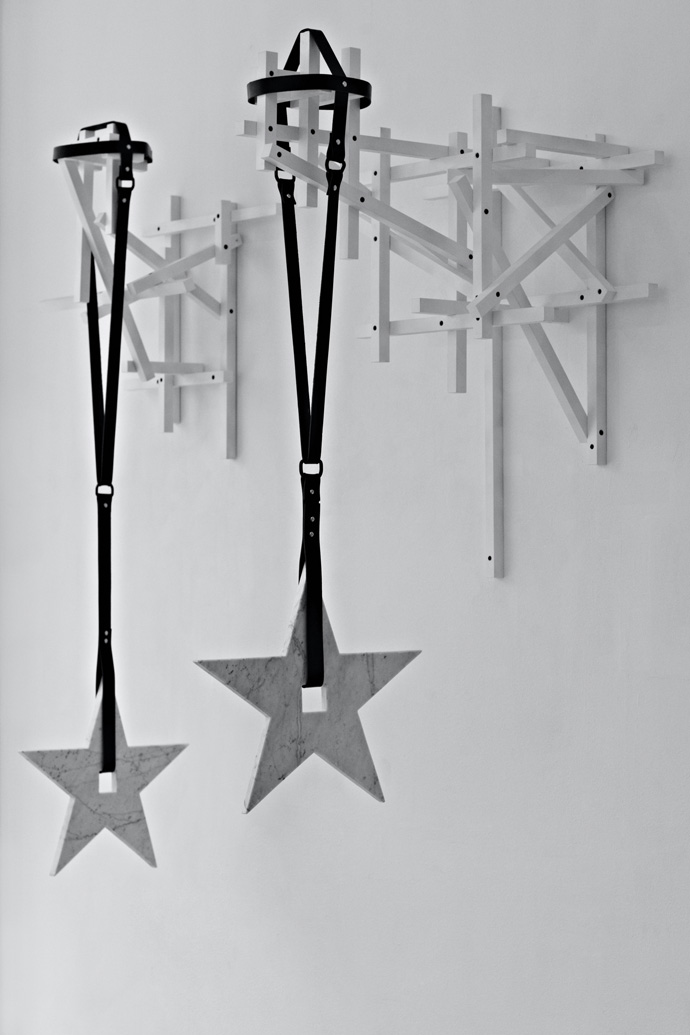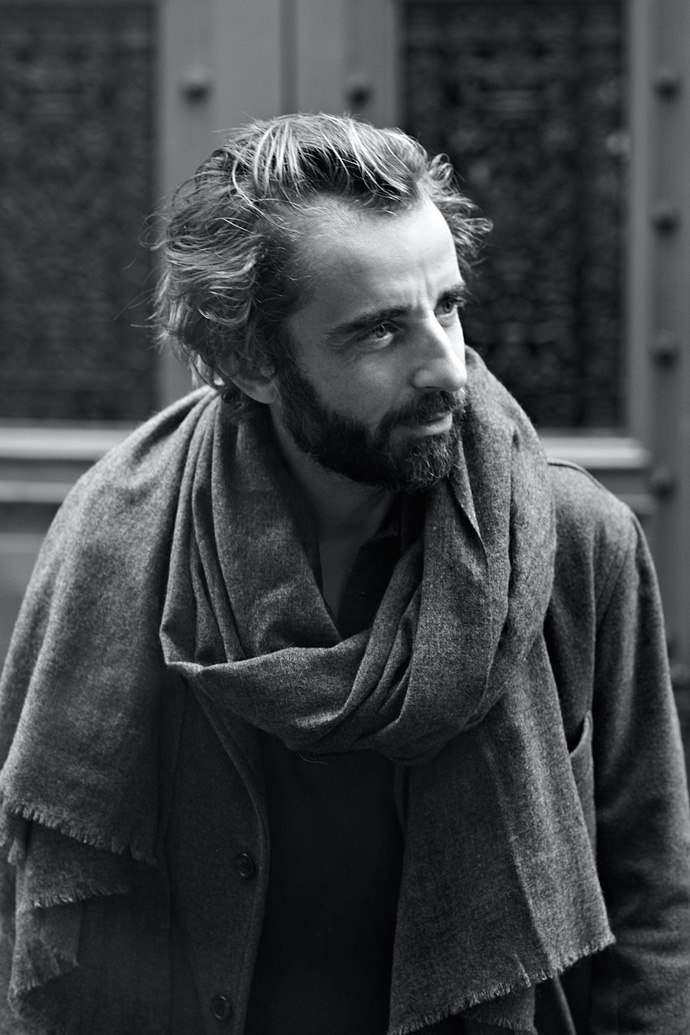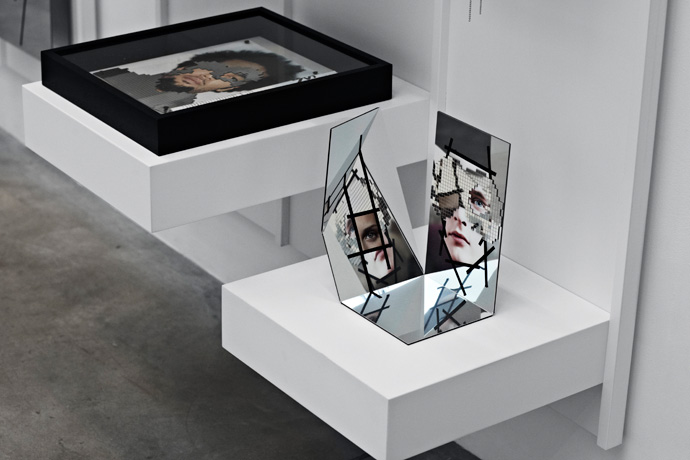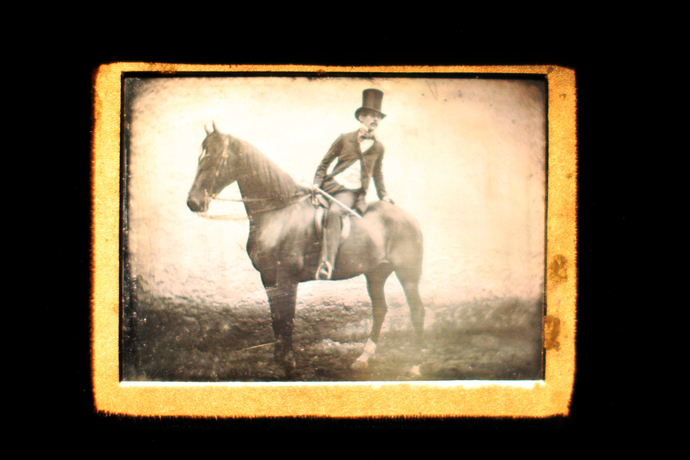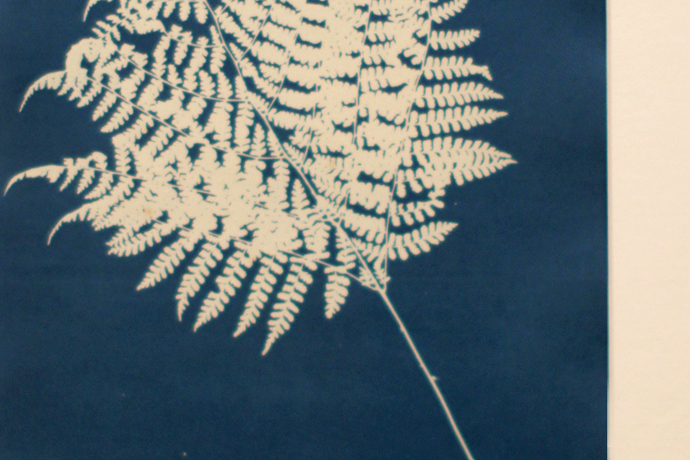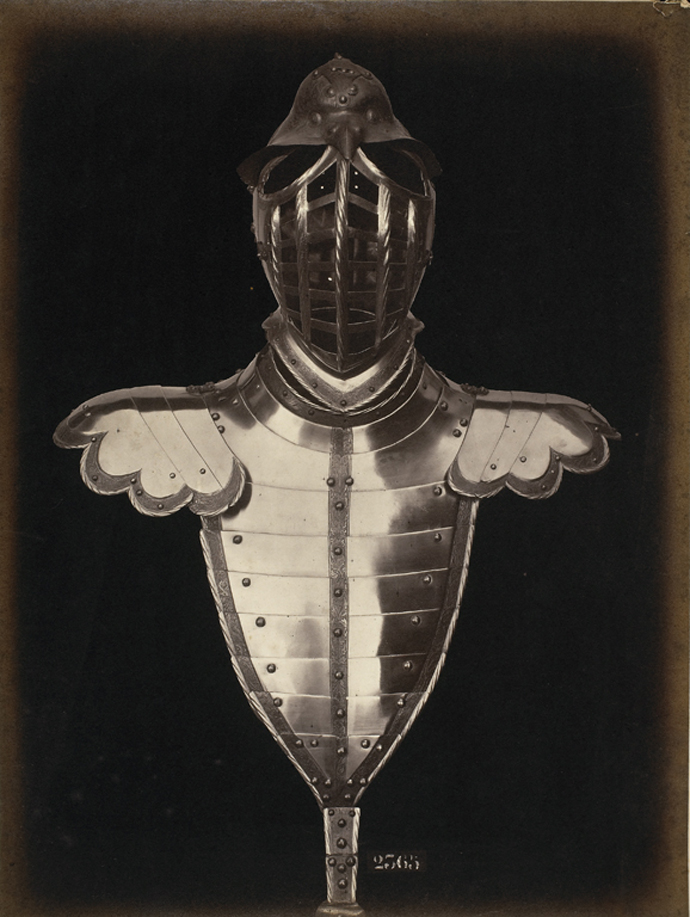-

Guy Bérubé and his Petite Mort
-It has been one year now since I moved to Ottawa, Canada. During the past year I’ve come across a few people who are always trying to make the city exciting. Guy Bérubé, a good friend now, is one of them. He owns a gallery – La Petite Mort, a place where taxidermy meets with iconic furniture pieces and fundraising art sales for several charities (including Guy’s own).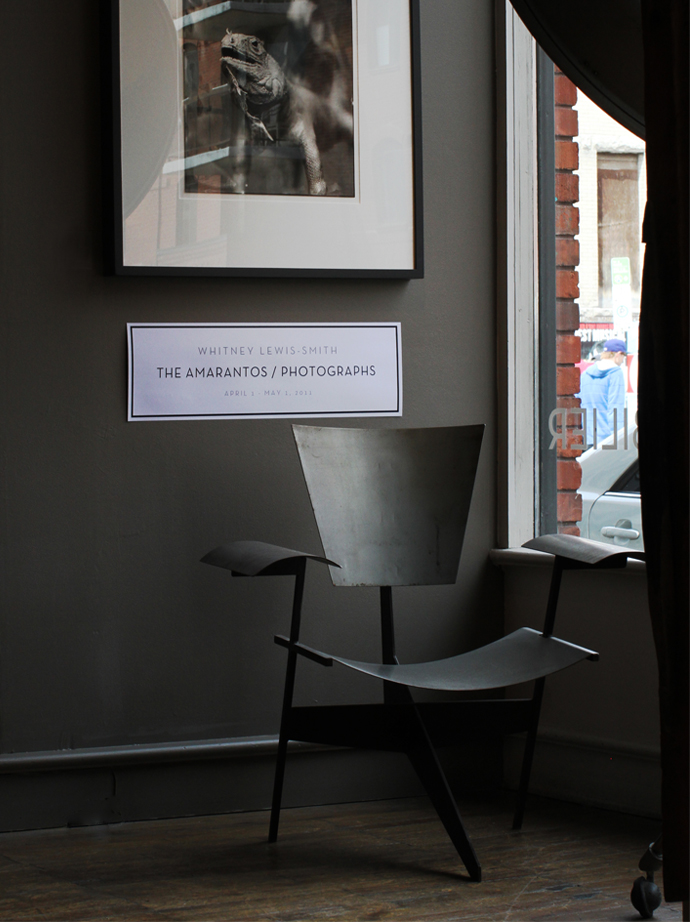 Lizard photo: Whitney Lewis-Smith.Far from presenting “Hockey art” or Canadian landscapes, in Guy’s gallery you will find work ranging from portraits of the city’s crack addicts by photographer Tony Fouhse, to poems on pieces of cardboard by Crazzy Dave of the Ottawa homeless community.With the look and fame of a bad boy, I can only say that Guy is doing a great job for the art community in Canada: making art available and affordable to whoever is interested.
Lizard photo: Whitney Lewis-Smith.Far from presenting “Hockey art” or Canadian landscapes, in Guy’s gallery you will find work ranging from portraits of the city’s crack addicts by photographer Tony Fouhse, to poems on pieces of cardboard by Crazzy Dave of the Ottawa homeless community.With the look and fame of a bad boy, I can only say that Guy is doing a great job for the art community in Canada: making art available and affordable to whoever is interested.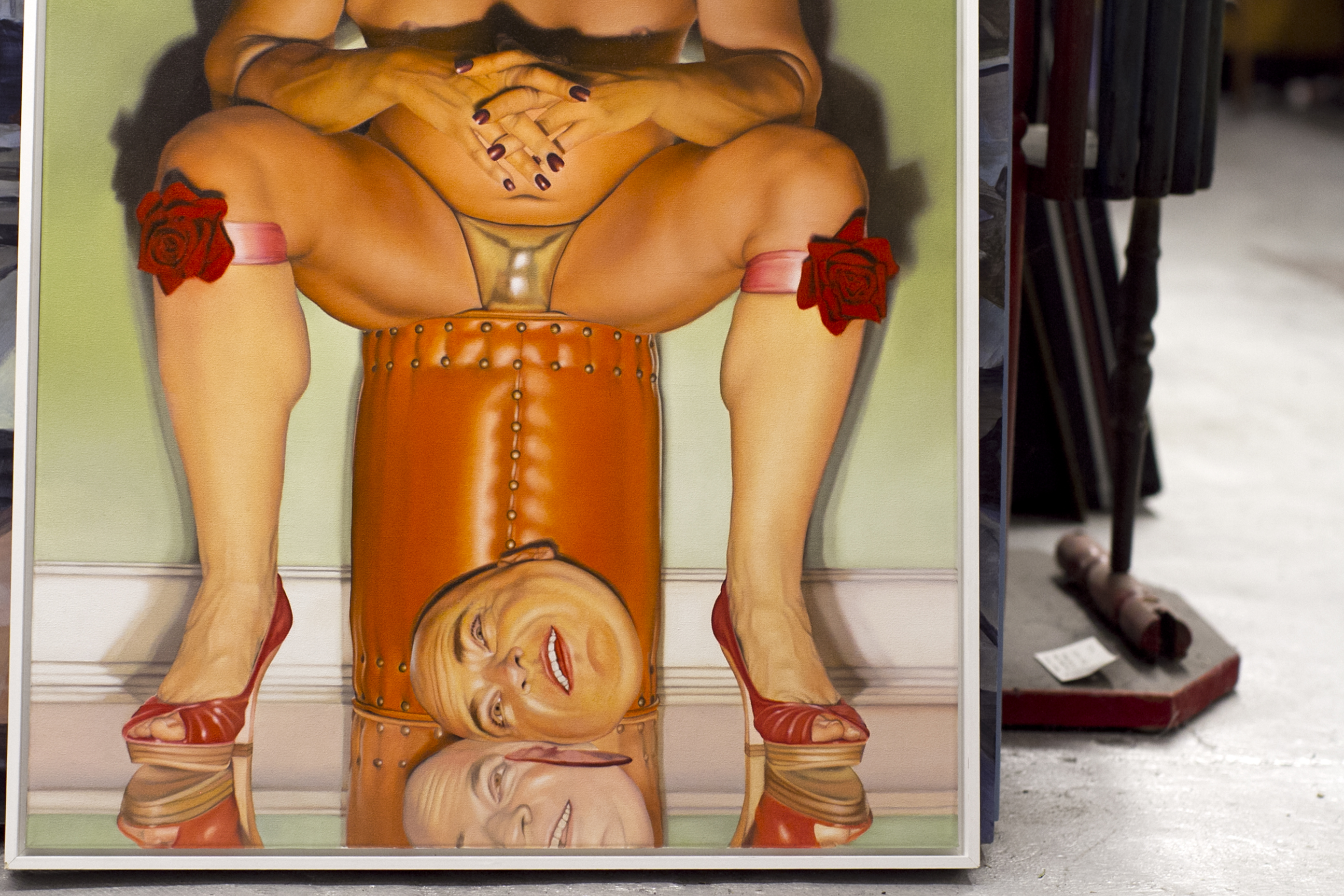 Legs with severed head (Guy's head, btw) Peter Shmelzer.What was the last thing that stimulated you?It happened here in Ottawa, it happened to be a lesbian wedding performance by former American prostitute and porn star turned performance artist, Annie Sprinkle, and her partner, hosted by SAWGallery. It was very interesting for me to see. They are already married, but they do an annual wedding with a theme, and this time here in Ottawa it was marriage to nature, and marrying snow. They are eco-sexual; they have sexual feelings about nature (laughs). I hadn’t seen Annie Sprinkle in over 25 years, and I had met her before at a performance in NY where she had a live orgasm on stage.So, it happened next door to my gallery at St. Brigid’s (a deconsecrated Church), and a lot of people came, and they saw the look and the aesthetics of a wedding. Everybody wearing white, everything was beautifully decorated, the light was coming through the stained glass… but then the performance started. They rode a pile of snow, exposing themselves by lifting their wedding dresses, and then inserted icicles up their vaginas, as they recited their wedding vows.That seems a bit unusual for the city…I’m seeing change, slowly but surely, over the 10 years that I have been here. I know that I’ve had some credit for some of the change. I’m seeing a difference in the art that is featured in galleries, even the Municipal galleries are showing things from my artists. It is something positive; Ottawa is a city where there is a possibility of starting from scratch, even though you’ve seen it in other places. Ottawa is a funny little town, very voyeuristic; it’s like the dude at the orgy who complains about the bad drapes and doesn’t jump into the fun.What would be a good example of this change coming from your gallery and artists?
Legs with severed head (Guy's head, btw) Peter Shmelzer.What was the last thing that stimulated you?It happened here in Ottawa, it happened to be a lesbian wedding performance by former American prostitute and porn star turned performance artist, Annie Sprinkle, and her partner, hosted by SAWGallery. It was very interesting for me to see. They are already married, but they do an annual wedding with a theme, and this time here in Ottawa it was marriage to nature, and marrying snow. They are eco-sexual; they have sexual feelings about nature (laughs). I hadn’t seen Annie Sprinkle in over 25 years, and I had met her before at a performance in NY where she had a live orgasm on stage.So, it happened next door to my gallery at St. Brigid’s (a deconsecrated Church), and a lot of people came, and they saw the look and the aesthetics of a wedding. Everybody wearing white, everything was beautifully decorated, the light was coming through the stained glass… but then the performance started. They rode a pile of snow, exposing themselves by lifting their wedding dresses, and then inserted icicles up their vaginas, as they recited their wedding vows.That seems a bit unusual for the city…I’m seeing change, slowly but surely, over the 10 years that I have been here. I know that I’ve had some credit for some of the change. I’m seeing a difference in the art that is featured in galleries, even the Municipal galleries are showing things from my artists. It is something positive; Ottawa is a city where there is a possibility of starting from scratch, even though you’ve seen it in other places. Ottawa is a funny little town, very voyeuristic; it’s like the dude at the orgy who complains about the bad drapes and doesn’t jump into the fun.What would be a good example of this change coming from your gallery and artists?
The USER series by Tony Fouhse is a perfect example of what my gallery does, something of which I’m very proud. It was featured in New York Times, Japan Newsweek… people got it, but it was very difficult at the beginning; lots of people in the neighbourhood, politicians, people were very against the work.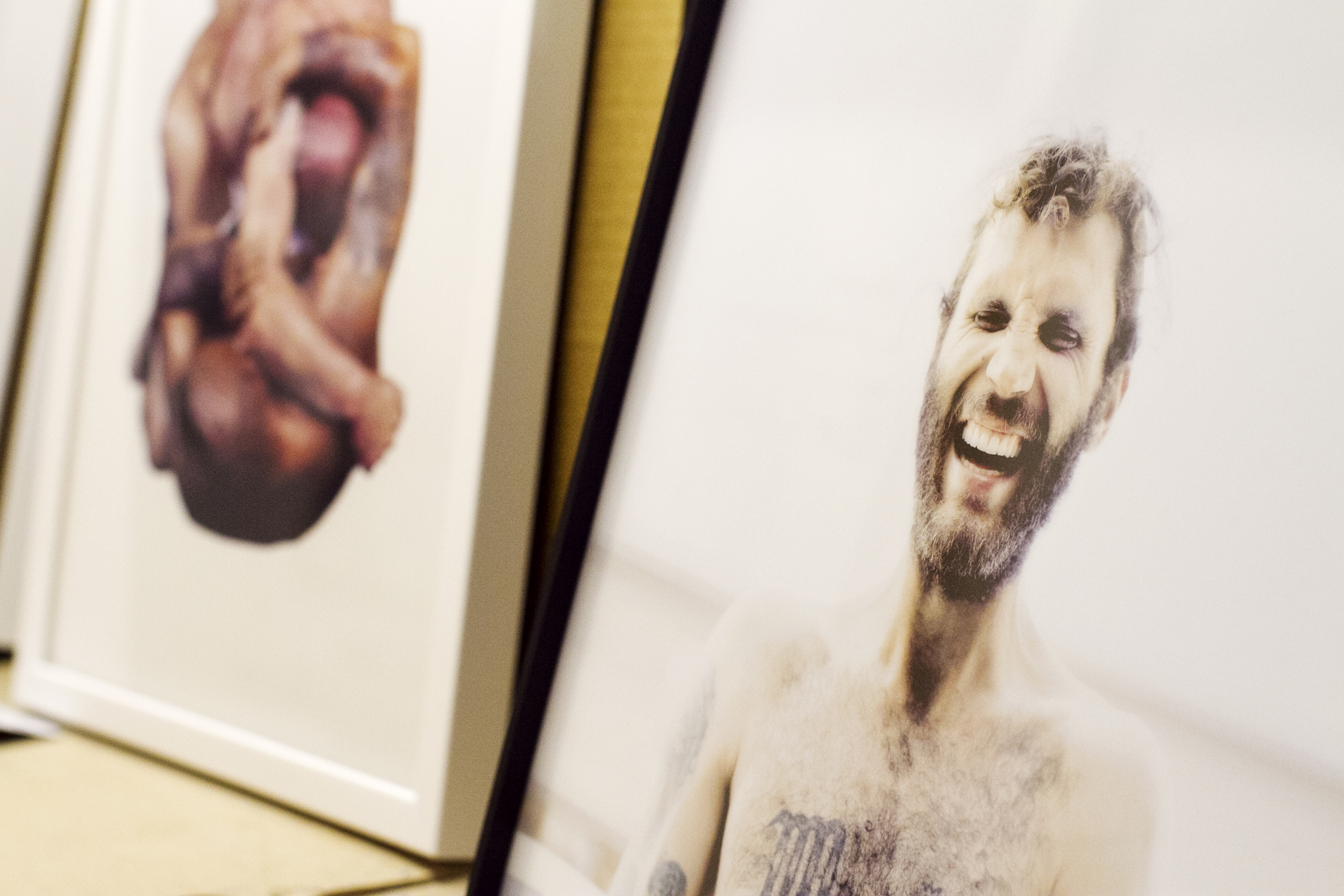 Men wrestling: Matthew Dayler / Photo of man laughing: Tony Fouhse.
Men wrestling: Matthew Dayler / Photo of man laughing: Tony Fouhse.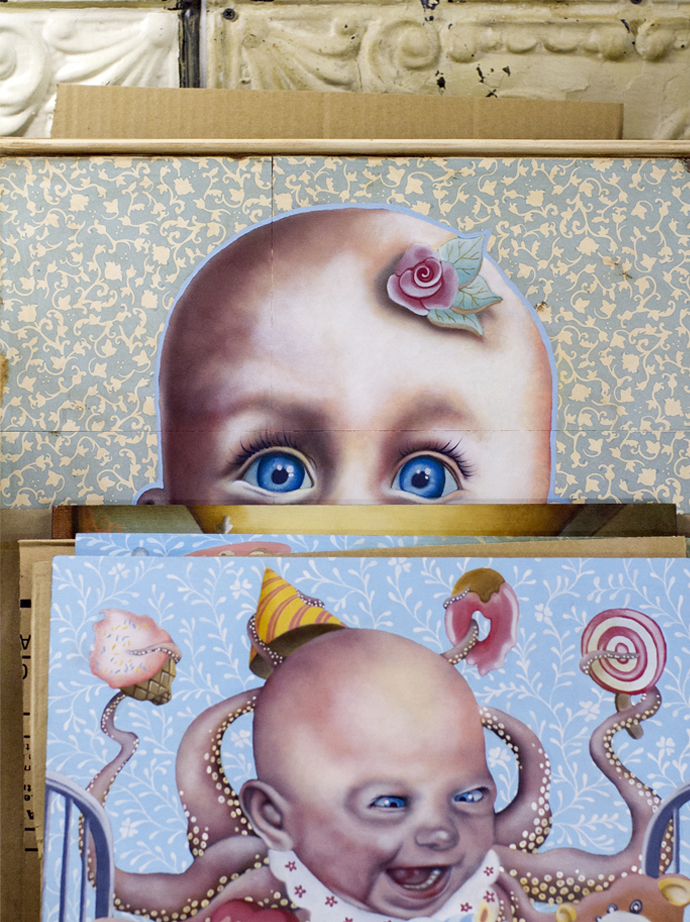 Creepy baby head: Robert Farmer.What’s the deal with the stuffed animals?Before I had the gallery I had the fake tortoiseshell lamp, which I bought in Paris, and then I bought, not knowing why, the baboon. I think I felt sorry for him, it was on the floor of a junk store and people were grossed out by it, so I paid $20. And so, when I got the gallery, a friend of mine asked me if I was going to bring the “creepy animals”. Then people just started bringing their stuffed animals to me, and it became a depository, kind of like an orphanage. You can bring your stuffed animal, but it needs to have a good valid story, like all the other animals there. I’m not online desperately looking for an owl! I don’t buy them.
Creepy baby head: Robert Farmer.What’s the deal with the stuffed animals?Before I had the gallery I had the fake tortoiseshell lamp, which I bought in Paris, and then I bought, not knowing why, the baboon. I think I felt sorry for him, it was on the floor of a junk store and people were grossed out by it, so I paid $20. And so, when I got the gallery, a friend of mine asked me if I was going to bring the “creepy animals”. Then people just started bringing their stuffed animals to me, and it became a depository, kind of like an orphanage. You can bring your stuffed animal, but it needs to have a good valid story, like all the other animals there. I’m not online desperately looking for an owl! I don’t buy them.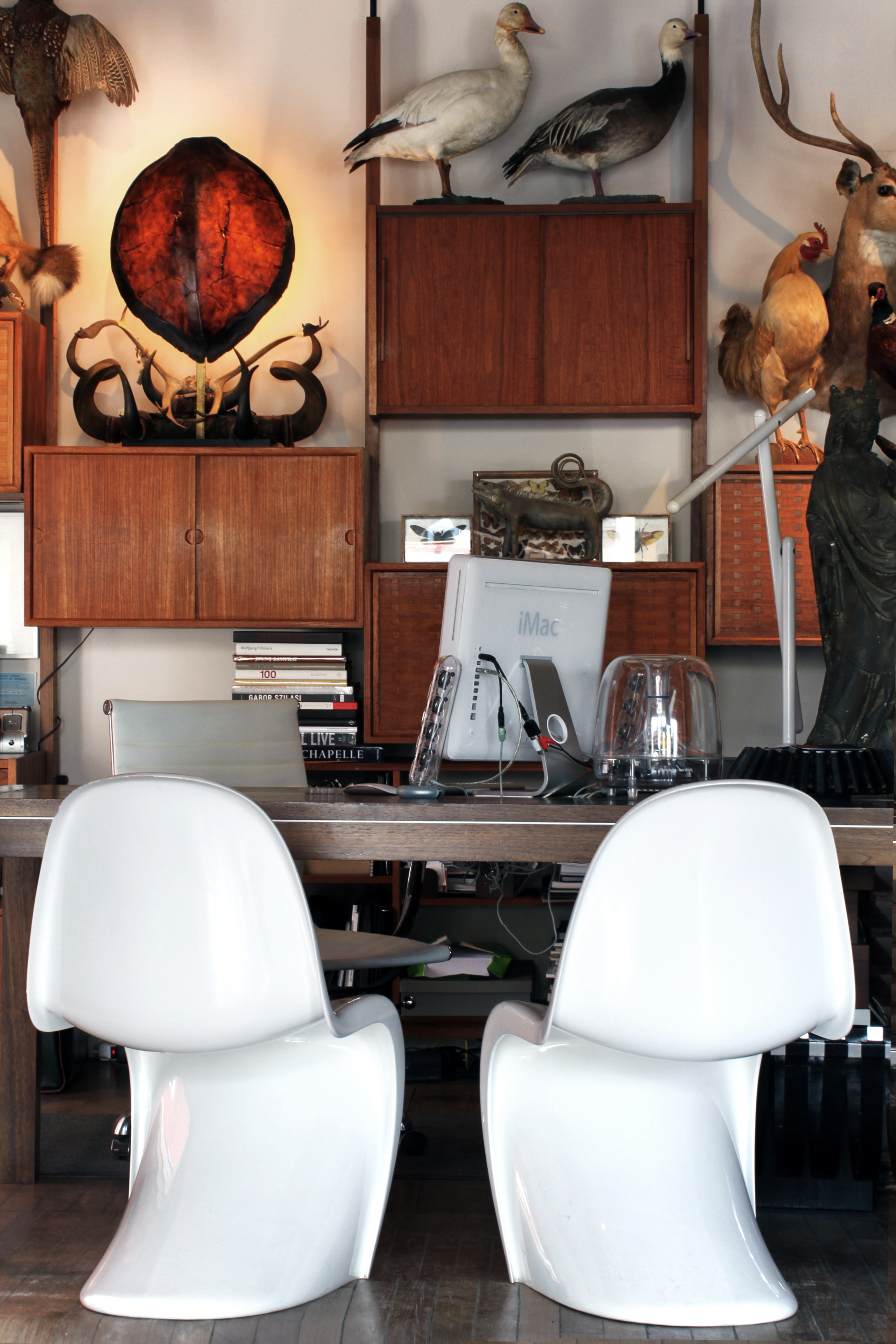
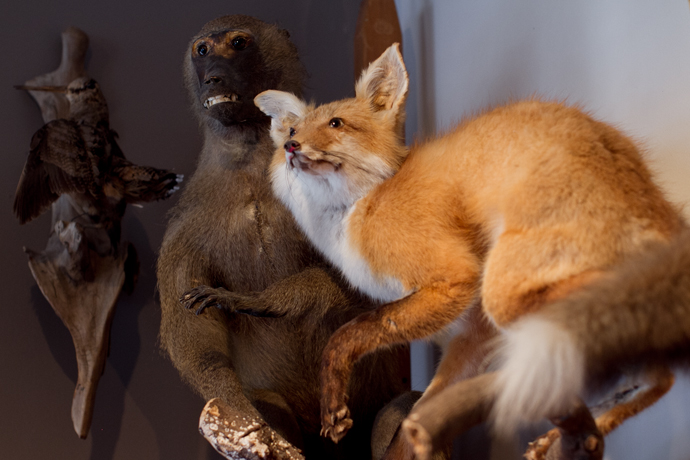 Guy's taxidermy collection.You must have some good stories…A woman once told me she wanted to give me a bison’s head, and I have always loved the look of them.So, we had a long conversation, and in the end she told me, “well, it hasn’t been taxidermied yet, it’s just the severed head” (laughs…) it was frozen!!!Make sure to check out La Petite MortSLAVA MOGUTIN & BRIAN KENNY
Guy's taxidermy collection.You must have some good stories…A woman once told me she wanted to give me a bison’s head, and I have always loved the look of them.So, we had a long conversation, and in the end she told me, “well, it hasn’t been taxidermied yet, it’s just the severed head” (laughs…) it was frozen!!!Make sure to check out La Petite MortSLAVA MOGUTIN & BRIAN KENNY
September 2 – October 2, 2011
INTERPENETRATION
Photographs & Drawings www.lapetitemortgallery.com00 -

marc turlan: STAR NOTORIOUS
-First, he covered them up with a resin mask, then he cut their eyes out, with a scalpel and after with a laser. This is not Dexter, this is artist Marc Turlan, who always finds new ways of torturing magazines.With his latest solo show EXO STAR he is taking an artistic leap, opening this saturday at Galerie Anne de Villepoix in Paris.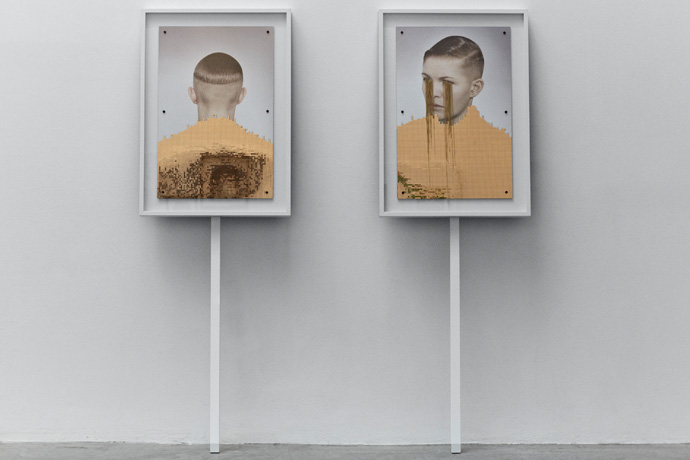 Marc Turlan: protest board 1 and 2, a collaboration with british photographer Timur Celikdag.
Courtesy gal Anne de VillepoixThe new sculptures of Marc Turlan conclude a logical extension of his appropriative work with the pages of glossy magazines:“The base of all i do is collage. The technique for my sculpture is the same way, it’s like 3 dimensional collages.”Right in the first room, the program for the exhibit gets clear: a gym workbench, weight bars in a stack, and 6 sheets of mirror, each with a word inscription of mirror mosaic, that serve as the commandments for this show: WORK – NOTORIETY – SINCERITY – POWER – LOVE
Marc Turlan: protest board 1 and 2, a collaboration with british photographer Timur Celikdag.
Courtesy gal Anne de VillepoixThe new sculptures of Marc Turlan conclude a logical extension of his appropriative work with the pages of glossy magazines:“The base of all i do is collage. The technique for my sculpture is the same way, it’s like 3 dimensional collages.”Right in the first room, the program for the exhibit gets clear: a gym workbench, weight bars in a stack, and 6 sheets of mirror, each with a word inscription of mirror mosaic, that serve as the commandments for this show: WORK – NOTORIETY – SINCERITY – POWER – LOVE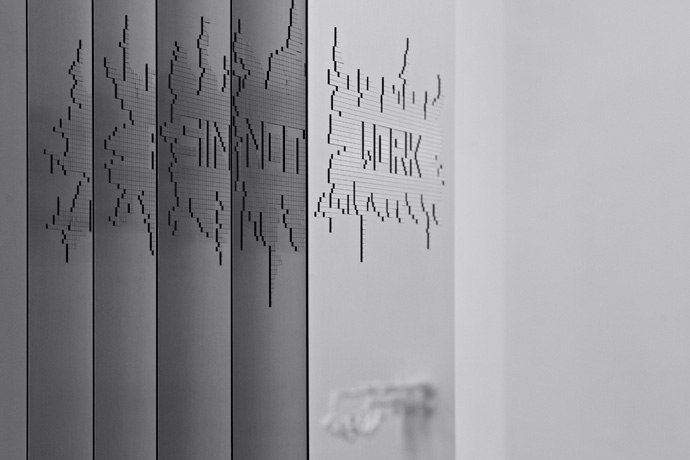 Marc Turlan: Statement Carpets. Courtesy gal Anne de Villepoix“It’s about the body. it’s erotic. Its a fetish to have in your mind to transform your body, to make a new image of yourself” he explains, next to two sculptures that look like snaffle headpieces with star shaped marble weights hanging from its leather thongs. It is inspired by gym gear to work your trapezius muscle. The materials surrounding us – leather, marble, mirror, wood. Marc Turlans recurrent structural elements are evident: eroticism, vanity, fetishism and notoriety.
Marc Turlan: Statement Carpets. Courtesy gal Anne de Villepoix“It’s about the body. it’s erotic. Its a fetish to have in your mind to transform your body, to make a new image of yourself” he explains, next to two sculptures that look like snaffle headpieces with star shaped marble weights hanging from its leather thongs. It is inspired by gym gear to work your trapezius muscle. The materials surrounding us – leather, marble, mirror, wood. Marc Turlans recurrent structural elements are evident: eroticism, vanity, fetishism and notoriety.Left: Marc Turlan's "Star Rack", and right: the artist himself
And there is of course, the star: “The star is the representation of the absolute, its a simple symbol for everyone. This desire, or fantasy to be recognised, to be famous, to arrive at this point… I use the star in marble.”In Marc Turlans “gym” you actually work out with the star as a marble weight, stemming the symbol of the desired recognition and thus transform yourself through and towards that idea.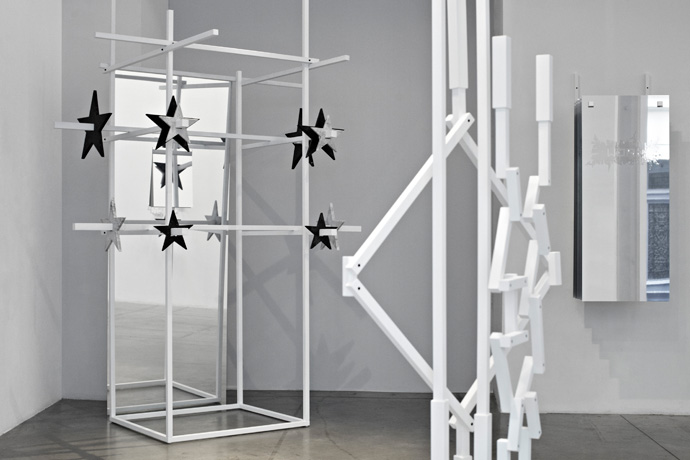 The first room of EXO STAR with "Home Star-Gym". Courtesy Gallery Anne de VillepoixThe second room is pitch black and only lit by pulsating light bulbs on a cluster of stars, an array of audio sculptures speak to the visitor with each a “collage sonore” (sound collage). Corresponding to the acoustic rework of a writers text hangs a framed object, containing a book of the same author with a mirror mosaic highlighting a sentence.“I keep a sentence very different to the audio collage. It is a proposition, an open invitation. I don’t work in an interactive way. I am interested in the object. It becomes a sculpture” he explains.
The first room of EXO STAR with "Home Star-Gym". Courtesy Gallery Anne de VillepoixThe second room is pitch black and only lit by pulsating light bulbs on a cluster of stars, an array of audio sculptures speak to the visitor with each a “collage sonore” (sound collage). Corresponding to the acoustic rework of a writers text hangs a framed object, containing a book of the same author with a mirror mosaic highlighting a sentence.“I keep a sentence very different to the audio collage. It is a proposition, an open invitation. I don’t work in an interactive way. I am interested in the object. It becomes a sculpture” he explains.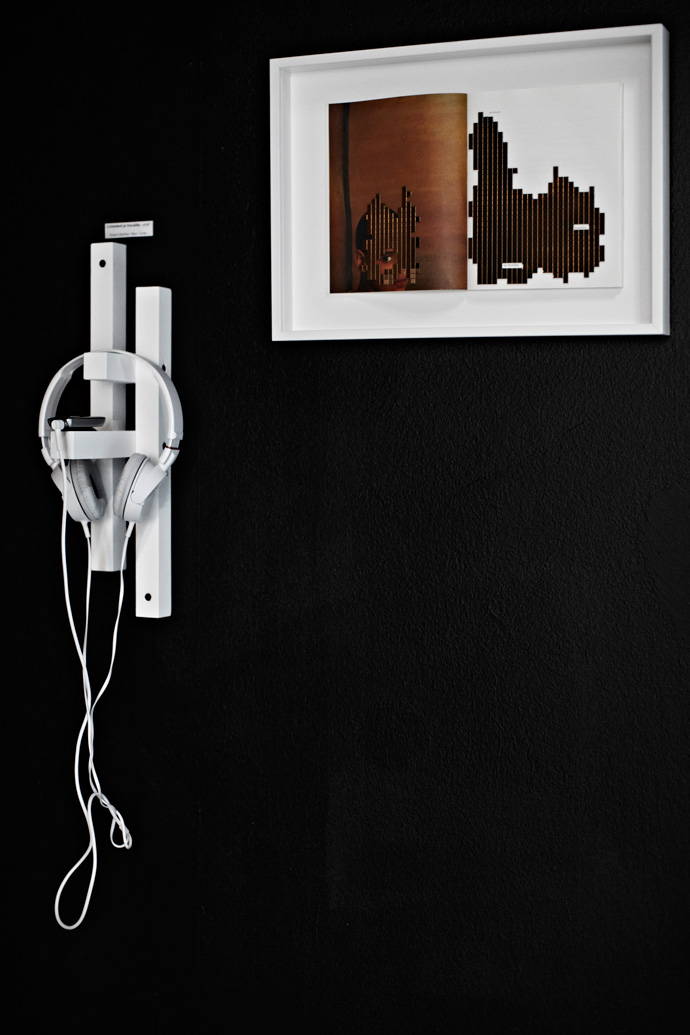
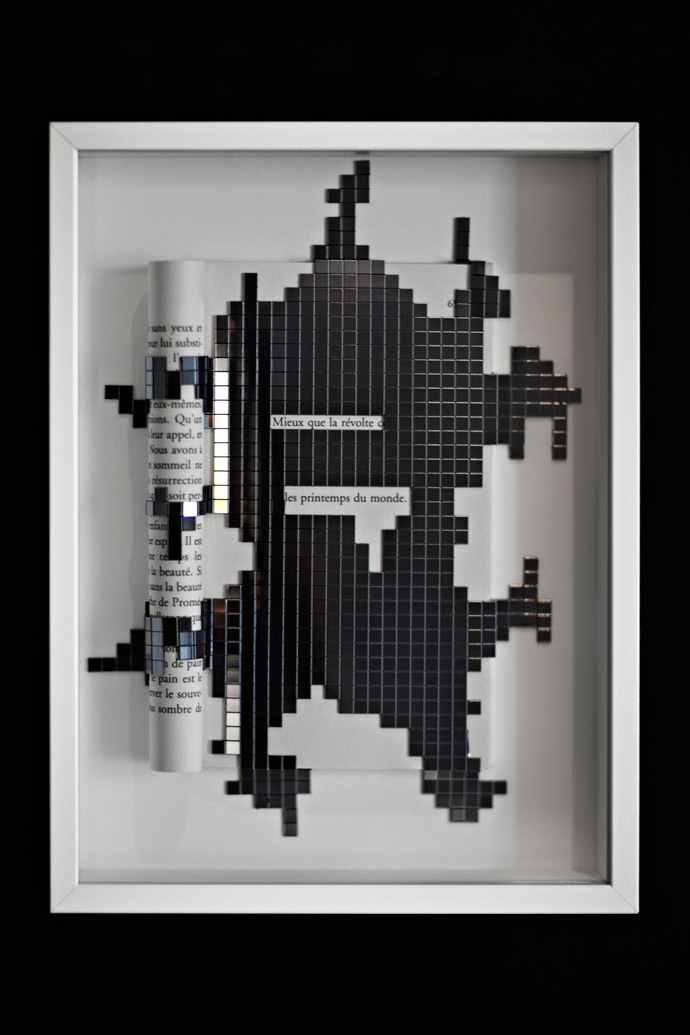 The collage sonore / sound collage installation in room 2. Courtesy Gallery Anne de VillepoixNear the pass to the next room the only book that depicts an image and with this marks the transition to the last complex of works. It’s all about stars and fashion magazines. But now the presentation enhances the fact that the magazines departed from being just the source of material. They become objects themselves, so does the frame and the fixture. It becomes altogether an installation: A cabinet of seven blocks present the works on shelves, hung, or in frames that at times can be turned and reveal a mirror. Mirrors everywhere. “Beyond, beyond, beyond the mirror”, as Patti Smith proclaims earlier in one of the audio collages.
The collage sonore / sound collage installation in room 2. Courtesy Gallery Anne de VillepoixNear the pass to the next room the only book that depicts an image and with this marks the transition to the last complex of works. It’s all about stars and fashion magazines. But now the presentation enhances the fact that the magazines departed from being just the source of material. They become objects themselves, so does the frame and the fixture. It becomes altogether an installation: A cabinet of seven blocks present the works on shelves, hung, or in frames that at times can be turned and reveal a mirror. Mirrors everywhere. “Beyond, beyond, beyond the mirror”, as Patti Smith proclaims earlier in one of the audio collages.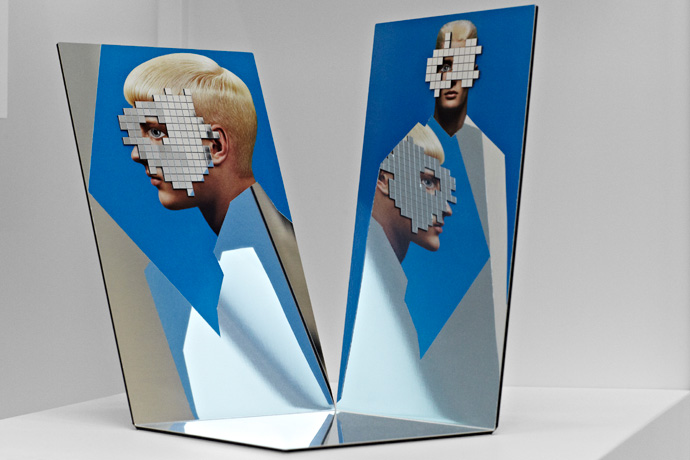 Object in room 3 at Gallery Anne de VillepoixMarc Turlan: EXO STARopening Saturday 10th, running to October 15th 2011at Galerie Anne de Villepoix, rue de Montmorency, 75003 Paris
Object in room 3 at Gallery Anne de VillepoixMarc Turlan: EXO STARopening Saturday 10th, running to October 15th 2011at Galerie Anne de Villepoix, rue de Montmorency, 75003 Paris -

Lori Pauli | Behind the 19th-Century British Photographs.
-Lori Pauli is the Associate Curator of Photographs at the National Gallery of Canada, home to more than 25,000 photographs in a collection that started in 1967.
She has recently put together the exhibition 19th-Century British Photographs; the third in a series of five exhibitions of selected masterpieces of the collection of the National Gallery. This exhibition traces the development of photography in Britain over the course of the Victorian era; from early, salted paper prints, to daguerreotypes, to magnificent turn-of-the-century platinum prints.
I met Lori at a guided tour of the exhibition. Ann Thomas, also a curator at the National Gallery, whom I had met in one of the events I organized introduced me to her and we briefly talked about meeting up to chat about Mexican artists included in the collection amongst other things.
Not too long after we met and talked about astrophotography, the Moderna Museet in Stockholm, Ron Mueck, her twin sister and some of the cultural differences I have noticed while in Canada.
For my first contribution to The Stimuleye, I will be sharing some of the questions I had for her on the exhibition.
Miguel Batel: How did the idea for this exhibition came together?
Lori Pauli: Basically, with our drawings collection we started a series of exhibitions based on our holdings, so we decided for photographs we would do the same thing. The first one was modern photographs from the collection, then we did 19th-Century French, and after this it will be American Photography from 1900 to 1950.
The fifth probably will be either American 1950 to the present, or possibly our holdings of Canadian photography.
Will this exhibition be travelling?
It will, I’m not sure exactly where it’s travelling, we have had interest from across the country, and we are just deciding where its going to end up.
How many photographs did you have to go through, and how many are currently exhibited?
There are about 112 photographs in the show, and I think I went through 2,000 in terms of 19th-Century photographs from the collection, so there was quite a bit to choose from, which was great.
The exhibition features some of the earliest photographic techniques. Which are some of the photographs you would consider to be the most important?
Well, of course some of the earliest would be the daguerreotypes, and we have a really great daguerreotype, that is quite large format; I don’t know if you remember it, but its of a man called John Berret Nelson and its around 8” by 10”, its fairly large compared to what normal daguerreotype sizes are. It’s called a mammoth plate, its beautifully created – masterfully crafted- and it comes with its original frame as well, so that is a real gem in the collection.
In terms of British we have a lot of salted paper prints by William Henry Fox Talbot, so those are other also really important pieces, because that’s the inventor of paper photography, it’s really great to have those.
Are there any borrowed items?
No, it is all from the collection.
You acquired some photographs for this exhibition, any specially difficult one to get?
One of them was the piece of armour, we think its by a woman called Jane Clifford. She was married to Charles Clifford, who was the most important photographer working in Spain. He made a lot of use of Queen Isabelle II construction projects and he did use of her armoury and her treasures. We recently acquired that.
